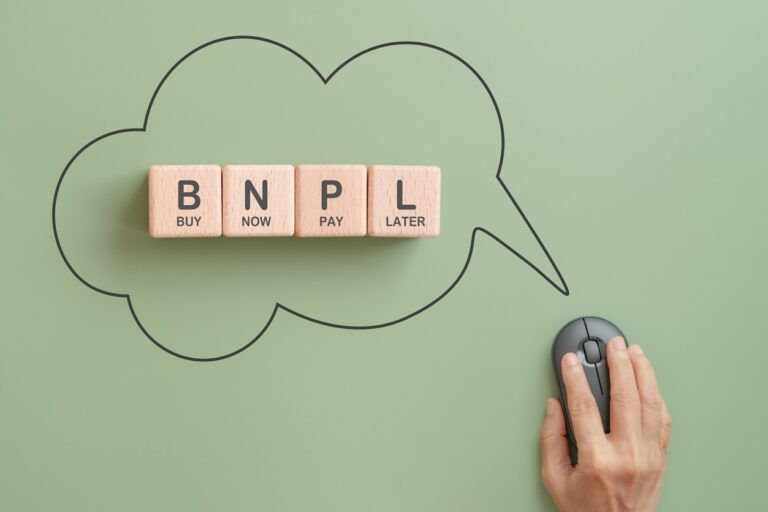On this page
What's next
Earn a high-yield savings rate with JG Wentworth Debt Relief
2025: Higher Prices and the Rise of Buy Now, Pay Later
by
JG Wentworth
•
June 9, 2025
•
8 min

In neighborhoods across America, a troubling pattern has emerged: consumers are increasingly turning to financial services like Affirm, Klarna, and Afterpay to purchase everyday necessities as prices continue to climb. This convergence of rising retail prices with readily available buy now, pay later (BNPL) financing represents a fundamental shift in how Americans manage household budgets and navigate economic insecurity.
Meanwhile, Walmart has implemented multiple price increases across its stores, citing ongoing supply chain pressures, labor costs, and inflation. For millions of Americans already walking a financial tightrope, these dual trends have created a perfect storm that threatens long-term financial stability.
Let’s take a closer look at what this means for American consumers such as yourself…
The rise of prices, and BNPL, for essentials
Walmart, long known for its “everyday low prices” mantra, has incrementally raised prices across multiple product categories since 2023. For example:
- The price of bananas, imported from Costa Rica, rose from 50 cents per pound, to 54 cents.
- Car seats made in China that currently sell for $350 at Walmart will likely cost customers another $100.
These price hikes have been particularly pronounced in Walmart’s private label “Great Value” products, which have historically served as budget alternatives for price-conscious shoppers.
According to Forbes, the number of US consumers who are using BNPL transactions for groceries and household essentials have grown by 14% in 2024 and 21% in 2023. Walmart’s integration with multiple BNPL providers has facilitated this trend, with in-store signage and checkout prompts actively promoting these payment options (groceries now accounting for roughly 60% of Walmart’s U.S. business).
Walmart has aggressively incorporated BNPL options into both its online and in-store shopping experiences. The retailer currently partners with Klarna, offering prominent placement of this service at checkout. In-store, cashiers are reportedly instructed to mention BNPL options to customers whose transactions exceed $50.
The pitfalls of BNPL for consumers
BNPL services, which allow consumers to split payments into installments—typically interest-free if paid on time—initially gained popularity for discretionary purchases like electronics and fashion. However, their usage has drastically shifted in recent years.
BNPL (Buy Now, Pay Later) services can be harmful to consumers for several key reasons:
- Hidden debt accumulation: They make it easy to accumulate multiple small debts that add up quickly, often without the consumer fully realizing their total financial obligations.
- Lack of regulatory protections: Many BNPL services operate in regulatory gray areas with fewer consumer protections than traditional credit products.
- Late fees and penalties: They often charge significant late fees that can make purchases much more expensive than the original price.
- Impact on credit scores: Some BNPL services report late payments to credit bureaus, potentially damaging credit scores, while not reporting on-time payments that would build credit.
- Psychological disconnect: They separate the pleasure of purchasing from the pain of payment, making it easier to overspend.
- Normalization of debt for essentials: As noted in the article, they’re increasingly being used for necessities like groceries, creating ongoing financial obligations for items that have already been consumed.
- Limited underwriting: Many BNPL providers conduct minimal creditworthiness checks, potentially allowing consumers to take on debt they cannot afford to repay.
- Encouragement of impulse purchases: The “pay in 4” model reduces the perceived cost, encouraging consumers to make purchases they might otherwise reconsider.
Who bears the burden?
According to Numerator, their data indicates that BNPL users tend to be Gen Z or Millennial multi-cultural, urban families earning under $60,000 per year. Factoring in cost of living, household size, and regional differences, these users are 42% more likely to fall into the lower third of purchasing power. They also make 28% more grocery trips using SNAP benefits when compared with non-users.
Gen Z and Millennials are 50% more likely than average to use BNPL for experiences—think concerts and festivals—and they are also more inclined to finance personal travel and exercise equipment. Numerator’s findings suggest that 39% of BNPL users leverage these services for holiday purchases, and 36% do so around large retail sales events. Purchasing data further shows BNPL users contribute a higher share of their general merchandise purchases during holidays and Amazon Prime Big Deal Days.
Current regulatory framework
BNPL services occupy a regulatory gray area that has allowed for rapid growth with minimal oversight. Unlike credit cards, which are governed by the Truth in Lending Act and require specific disclosures, many BNPL providers have operated under more limited regulatory constraints.
The Consumer Financial Protection Bureau issued its first comprehensive report on BNPL services in September 2023, highlighting concerns about debt accumulation, data collection, and regulatory arbitrage. However, comprehensive federal regulations specific to BNPL have yet to be implemented.
Several states, including California and Massachusetts, have introduced legislation requiring greater transparency from BNPL providers, particularly around late fees and credit reporting practices. These efforts remain piecemeal, creating an inconsistent landscape of consumer protections.
Take your next step towards being debt-free
"*" indicates required fields
Alternatives to BNPL services
Before committing to a BNPL service, consider the following:
- Cash budgeting/envelope system: Allocating cash for specific expense categories to ensure spending within means.
- Traditional savings: Setting aside small amounts regularly for planned purchases instead of paying after the fact.
- Community resource programs: Food banks, community fridges, and assistance programs for essential needs.
- Credit union loans: Often offer more favorable terms than commercial lenders for small, short-term loans.
- Zero-interest credit card promotions: Can provide interest-free financing with more consumer protections than BNPL (though requires discipline).
- Buy-in-bulk cooperatives: Community groups that purchase staples in quantity to reduce per-unit costs.
- Flexible payment arrangements: Many utility companies and service providers offer hardship programs with extended payment terms.
Why prioritizing debt relief payments is critical
Despite rising costs and inflation, prioritizing debt relief payments remains essential because:
- Compounding interest: Delaying payments allows debt to grow exponentially, making the long-term financial burden significantly worse.
- Credit score protection: Maintaining payment schedules preserves credit scores, which affects everything from future borrowing costs to rental applications.
- Program integrity: Most debt relief programs require consistent payments to maintain eligibility; missing payments can result in program termination.
- Legal consequences: For structured settlements like bankruptcy payment plans, failing to maintain payments can have serious legal repercussions.
- Long-term financial health: Short-term sacrifices to maintain debt payments create a more stable financial foundation for the future.
- Psychological benefits: Successfully completing debt payments builds financial confidence and reduces stress despite temporary hardship.
- Breaking the debt cycle: Completing debt relief programs allows consumers to escape the cycle of ongoing indebtedness that often leads to greater financial instability.
While inflation and rising costs make this challenging, adjusting other expenses or seeking additional income sources is typically more beneficial than compromising debt relief commitments.
The bottom line
The combination of rising prices at America’s largest retailer and the proliferation of financing options for everyday necessities represents a troubling shift in American consumer behavior. When households must finance basic needs like groceries and household supplies, it signals fundamental problems in the relationship between wages, essential goods pricing, and financial wellbeing.
For millions of Americans caught between stagnant wages and rising costs, BNPL services offer a temporary bridge but potentially deepen long-term financial vulnerability. As this trend continues, policymakers, industry leaders, and communities must grapple with the profound implications for economic stability and household financial health.
There’s always JG Wentworth…
If rising costs of living are impacting your ability to repay your debt, consider our Debt Relief Program.* If you have $10,000 or more in unsecured debt there’s a good chance you’ll qualify and some of our program perks include:
- One monthly program payment
- We negotiate on your behalf
- Reduce your total amount owed by an average of 43%
- Average debt resolution in as little as 24-60 months
- We only get paid when we settle your debt
If you think you qualify for our program, give us a call today so we can go over the best options for your specific financial needs. Why go it alone when you can have a dedicated team on your side?
SOURCES CITED
D’Innocenzio, A., “A rare warning from Walmart during a US trade war: Higher prices are inevitable.” Forbes. May 15, 2025
Faithfull, M., “U.S. Shoppers Turn To Buy Now, Pay Later For Groceries As High Costs Bite.” Forbes. April 28, 2025.
Fonrogue, G., “More Americans are financing groceries with buy now, pay later loans — and more are paying those bills late.” CNBC. April 26, 2025.
Green, R., “Klarna Buy Now, Pay Later Is Coming to a Walmart Checkout Screen Near You.” Kiplinger. March 24, 2025.
Scott, C., “5 Risks of Buy Now, Pay Later.” Charles Schwab. December 4, 2024.
Hudson, A. & Paustian, S., “Insights Into Buy Now, Pay Later: Growth & Trends 2025.” Numerator. February 14, 2025.
About the author
Recommended reading for you
* Program length varies depending on individual situation. Programs are between 24 and 60 months in length. Clients who are able to stay with the program and get all their debt settled realize approximate savings of 43% before our 25% program fee. This is a Debt resolution program provided by JGW Debt Settlement, LLC (“JGW” of “Us”)). JGW offers this program in the following states: AL, AK, AZ, AR, CA, CO, FL, ID, IN, IA, KY, LA, MD, MA, MI, MS, MO, MT, NE, NM, NV, NY, NC, OK, PA, SD, TN, TX, UT, VA, DC, and WI. If a consumer residing in CT, GA, HI, IL, KS, ME, NH, NJ, OH, RI, SC and VT contacts Us we may connect them with a law firm that provides debt resolution services in their state. JGW is licensed/registered to provide debt resolution services in states where licensing/registration is required.
Debt resolution program results will vary by individual situation. As such, debt resolution services are not appropriate for everyone. Not all debts are eligible for enrollment. Not all individuals who enroll complete our program for various reasons, including their ability to save sufficient funds. Savings resulting from successful negotiations may result in tax consequences, please consult with a tax professional regarding these consequences. The use of the debt settlement services and the failure to make payments to creditors: (1) Will likely adversely affect your creditworthiness (credit rating/credit score) and make it harder to obtain credit; (2) May result in your being subject to collections or being sued by creditors or debt collectors; and (3) May increase the amount of money you owe due to the accrual of fees and interest by creditors or debt collectors. Failure to pay your monthly bills in a timely manner will result in increased balances and will harm your credit rating. Not all creditors will agree to reduce principal balance, and they may pursue collection, including lawsuits. JGW’s fees are calculated based on a percentage of the debt enrolled in the program. Read and understand the program agreement prior to enrollment.
This information is provided for educational and informational purposes only. Such information or materials do not constitute and are not intended to provide legal, accounting, or tax advice and should not be relied on in that respect. We suggest that you consult an attorney, accountant, and/or financial advisor to answer any financial or legal questions.






